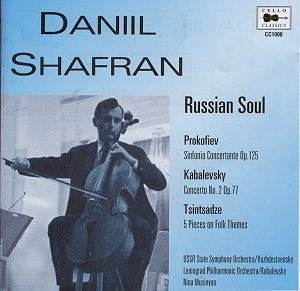Quite apart from being a miniature encyclopedia entry
on Shafran this is one of those discs that stays in the memory. It is
one that you will want to return to for Shafran's urgency, desperation,
fantasy and emotional range - never mind his extraordinary technical
accomplishments.
The whole production is to the great credit of Sebastian
Comberti's Cello Classics label. There are no fewer than nine excellent
portraits of Shafran in the booklet plus a scene-setting biographical
essay, full notes on each piece including a scan of the autograph dedication
to Shafran on the score of the Kabalevsky concerto … and Stephen Isserlis's
unmissable personal tribute. To cap it all the choice of repertoire
evades the obvious and embraces the delightfully and sometimes scarringly
unfamiliar.
The Prokofiev is a reworking of his Cello Concerto
in E minor from 1939. When premiered in February 1952 by Rostropovich
with the Moscow Youth Orchestra conducted by Sviatoslav Richter (his
first and only appearance as a conductor) it was called 'Cello Concerto
No. 2'. This work still strikes one overall as a piece in transition
not quite having found its butterfly form. Nevertheless it is alive
with Prokofiev's razor-sharp fantasy and romantic edginess. As an illustration
try the andante con moto at 5.12 where the composer conjures
a very unusual sense of exhausted collapse into strange harmonies and
textures.
Stanley Dale Krebs, the first full-time American student
at the Moscow Conservatoire, wrote of Kabalevsky possessing two of the
three qualities of a fine composer (superb technique and insight into
immediate popular success) but lacking the third (a personal depth that
must sometimes defy the other two qualities). Shafran's 1954 recording
of the First Concerto had given it currency across the USSR and
beyond. The composer dedicated his Second Cello Concerto to Shafran.
It is a work that has undeniable depth defying Krebs' condemnation.
The mood is intensified by the composer having opted for a slow-fast-slow
configuration - just as his teacher Miaskovsky had two decades previously
in his own cello concerto.
The five skilfully coloured Georgian folk sketches
by Tsintadze subtly usher central Asian material into the Soviet concert
tradition. These miniatures will appeal to anyone who has a taste for
the symphonies of Terteryan or Hovhaness. I wonder if Shafran included
any of these among the nine encores he played at that famous Wigmore
Hall concert back in the 1990s. We can only hope that young cellists
intent on shaking people from the complacent repertoire-round will think
of introducing these pieces into recitals and competitions.
I suspect, going by the very low level surface noise,
that these tracks came from Steven Isserlis's collection of MK and Melodiya
LPs. There are quite a few of us out here who would welcome a second
and third Shafran disc if Cello Classics can find enough unfamiliar
Russian material with which to fill them. Place this beside EMI's Rostropovich
'Russian Years' box and do not forget that Rostropovich was not the
only star in the USSR's firmament. Shafran and 'Slava' shared several
Soviet prizes. The accident of temperament, politics and promotional
drive separated Shafran from the international reputation enjoyed by
Rostropovich. When you hear this disc you will know what I mean. A treasure
and a pleasure.
Rob Barnett
